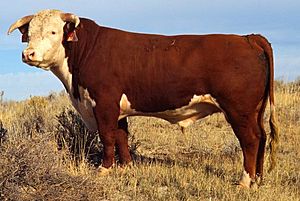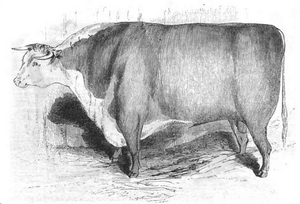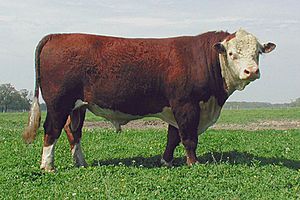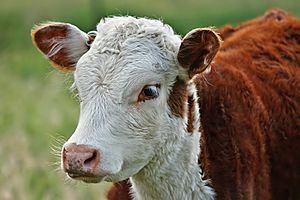Hereford cattle facts for kids

A Hereford bull
|
|
| Conservation status | Least Concern |
|---|---|
| Country of origin | Herefordshire, England |
| Use | Beef |
| Traits | |
| Weight |
|
| Height |
|
| Coat | Red, white |
| Horn status | White |
|
|

The Hereford is a famous type of beef cattle. It first came from Herefordshire, a county in England. Today, you can find Hereford cattle all over the world. There are more than five million purebred Herefords in over 50 countries!
These cattle were first sent out of Britain in 1817. They went to places like Kentucky in the United States. From there, they spread across North and South America. Now, Herefords are common in many places. This includes Australia, New Zealand, Canada, and parts of Europe. They are also found in Russia, Argentina, and South Africa. Herefords are very popular because they are tough. They can live well in many different climates, even harsh ones. The main group for Herefords around the world is the World Hereford Council. In the United States, the main group is the American Hereford Association.
Contents
History of Hereford Cattle
Before the 1700s, cattle in Herefordshire looked different. They were all red with a white tail, much like today's North Devon cows. But in the 1700s and early 1800s, farmers started to breed them differently. They mixed them with other cattle, like Shorthorns. This created a new type of cow. These cows were good for pulling carts and for their meat.
At first, the new Herefords came in many colors. They could be yellow, gray, or light brown. They also had different amounts of white on them. But by the late 1700s, the white face that Herefords are known for today became common. By the 1800s, their modern red and white color was set. You can still see Herefords in the English countryside today. They are also a big part of farm shows. The first Herefords came to the United States around 1817. This was thanks to a politician named Henry Clay. More of them were brought over in the 1840s.
Polled Hereford: No Horns!
The Polled Hereford is a special type of Hereford. These cattle are born without horns. This is because of a natural genetic change. Farmers noticed these hornless cows and decided to breed them separately. This started in 1889.
A cattle rancher from Iowa named Warren Gammon saw how useful hornless cattle could be. He began a special group for Polled Herefords. He started with 11 cows that were naturally hornless. The American Polled Hereford Association (APHA) was created in 1910. Since 1995, the American Polled Hereford and American Hereford groups have joined together. They are now both part of the American Hereford Association.
Traditional Hereford Cattle
Over time, many Hereford cows have been bred with other types of cattle. This was done to get certain traits that farmers wanted. Because of this, the Hereford breed has changed a bit. However, some groups of Herefords have been kept separate. These are called Traditional Herefords. They have kept the older traits of the breed. These traits include being very tough and good at finding food. Traditional Herefords are now seen as a special breed. They are important for keeping the original Hereford genes safe.
Health of Hereford Cattle
Like all animals, Herefords can have some health issues. One problem can be eye cancer. This is more common in places with lots of bright sunlight. It also happens more in Herefords that have less red color around their eyes. Studies have shown that having more color around the eyes can help protect them. Another issue is that their udders (where milk comes from) can get sunburned. This happens if the skin there is light-colored.
Sometimes, Hereford cattle can also have a condition called dwarfism. This is caused by a gene that can be passed down from parents. It affects both male and female calves equally.
See also
 In Spanish: Hereford (raza bovina) para niños
In Spanish: Hereford (raza bovina) para niños





